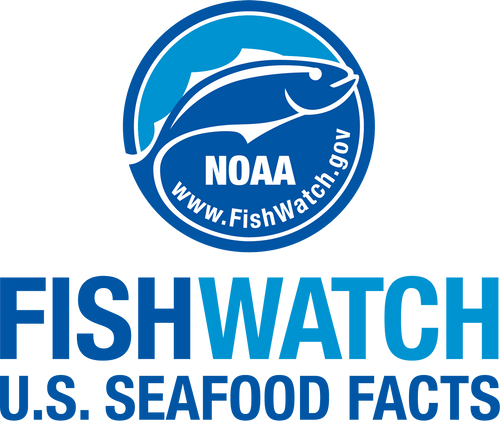About the Species
U.S. wild-caught brown rock shrimp is a smart seafood choice because it is sustainably managed and responsibly harvested under U.S. regulations.

Population
The population level is unknown, but management measures are in place.

Fishing Rate
Not subject to overfishing.

Habitat Impact
Gear restrictions, such as fishing prohibitions in certain areas and shrimp fishery access areas, are in place to protect deepwater coral habitat from trawl gear.

Bycatch
Regulations are in place to minimize bycatch.
Population Status
- According to the 2018 stock assessment, brown rock shrimp is not subject to overfishing. There is currently not enough information to determine the population size, so it is unknown. Summary stock assessment information can be found on Stock SMART.
- Brown rock shrimp are highly productive. Their population size varies naturally from year to year based on environmental conditions.
Appearance
- Brown rock shrimp have a thick, rigid, stony shell.
- Their bodies are off-white to pinkish in color, with the back surface darker and blotched or barred with lighter shades.
- Their legs are red to reddish-purple and barred with white. The abdomen has deep transverse grooves and numerous nodules.
- Short hairs cover their body and appendages.
- Their eyes are large and deeply pigmented.
- Brown rock shrimp are the deep-water cousin of white, pink, and brown shrimp also found in the warm waters of the southeastern United States. They are the largest of six rock shrimp species found in this area.
Biology
- Brown rock shrimp’s growth and development depends on factors such as water temperature and salinity. They can grow up to 6 inches in length, but most brown rock shrimp found in shallow waters are less than 2 inches long.
- They are highly productive and have a short life span, between 20 and 22 months.
- Females are able to reproduce when they reach at least ½ to 1 inch in length. Males mature when they reach about ½ inch long.
- Brown rock shrimp spawn year-round in offshore waters, with peaks between November and January. Individual females can spawn three or more times in one season.
- Males and females mate, and the eggs are fertilized when the female simultaneously releases egg and sperm. Eggs hatch within 24 hours.
- Juvenile and adult brown rock shrimp feed on the ocean floor, mainly eating small bivalve mollusks and crustaceans.
- Sheepshead, minnows, water boatmen, and insect larvae eat postlarval brown rock shrimp.
- A wide variety of species prey on juvenile and adult brown rock shrimp.
Where They Live
Range
- Brown rock shrimp are found from Norfolk, Virginia, south through the Gulf of Mexico to Mexico’s Yucatan Peninsula.
Habitat
- Brown rock shrimp mainly live on sand bottoms in water 80 to 215 feet deep, although they’ve been found in depths to 600 feet.
- They are active at night and burrow in the sand during the day.
- Larval brown rock shrimp grow and develop in coastal estuaries and travel back to offshore areas as they mature.
Fishery Management
- NOAA Fisheries and the South Atlantic Fishery Management Council manage the brown rock shrimp fishery.
- Managed under the Shrimp Fishery Management Plan:
- Permits are required to harvest shrimp in federal waters.
- Trip reports must be submitted for each fishing trip.
- Observers must be carried aboard selected vessels to collect data on catch, bycatch, fishing effort, and fishing gear.
- Managers set catch levels based on historic harvest amounts and fishing rates, rather than abundance, because brown rock shrimp are short-lived and heavily influenced by environmental factors.
- Vessels are prohibited from trawling in certain areas off Florida to protect deepwater coral habitat. To ensure compliance, brown rock shrimp vessels must carry vessel monitoring systems.
- Brown rock shrimp are occasionally caught in the Gulf of Mexico but not in quantities large enough to warrant specific management measures.
Harvest
- Commercial fishery:
- In 2022, landings of brown rock shrimp totaled 4 million pounds and were valued at $6.3 million, according to the NOAA Fisheries commercial fishing landings database.
- It is not uncommon for brown rock shrimp to experience considerable variations from year to year.
- Brown rock shrimp had limited marketability before 1969, when a machine was developed that could split the rock-hard shell and devein the shrimp. The first major harvest of brown rock shrimp (1,200 pounds) was recorded in 1970 and was valued at $642. Two years later, landings totaled 443,035 pounds and were valued at more than $258,000.
- Almost all the harvest is sold as meat because brown rock shrimp are difficult to peel.
- Gear types, habitat impacts, and bycatch:
- Commercial fishermen harvest shrimp with trawls towed near the ocean floor.
- Shrimpers using otter trawl gear in the South Atlantic and Gulf of Mexico are required to use sea turtle excluder devices (TEDs).
- Some shrimp trawlers must also install bycatch reduction devices behind the TED, to reduce finfish bycatch.
- Area closures if finfish bycatch exceeds certain thresholds.
- Fishermen do not trawl in areas with coral reefs and other known areas of high relief to avoid damage to their nets.
- Recreational fishery:
- Under federal management, there is no recognized recreational fishery. Fishing in federal waters requires a permit.
- Recreational fishermen catch brown rock shrimp seasonally and almost always in state waters. State regulations vary from state to state.
Scientific Classification
- Brown rock shrimp are found from Norfolk, Virginia, south through the Gulf of Mexico to Mexico’s Yucatan Peninsula.
- Brown rock shrimp mainly live on sand bottoms in water 80 to 215 feet deep, although they’ve been found in depths to 600 feet.
- They are active at night and burrow in the sand during the day.
- Larval brown rock shrimp grow and develop in coastal estuaries and travel back to offshore areas as they mature.
Fishery Management
- NOAA Fisheries and the South Atlantic Fishery Management Council manage the brown rock shrimp fishery.
- Managed under the Shrimp Fishery Management Plan:
- Permits are required to harvest shrimp in federal waters.
- Trip reports must be submitted for each fishing trip.
- Observers must be carried aboard selected vessels to collect data on catch, bycatch, fishing effort, and fishing gear.
- Managers set catch levels based on historic harvest amounts and fishing rates, rather than abundance, because brown rock shrimp are short-lived and heavily influenced by environmental factors.
- Vessels are prohibited from trawling in certain areas off Florida to protect deepwater coral habitat. To ensure compliance, brown rock shrimp vessels must carry vessel monitoring systems.
- Brown rock shrimp are occasionally caught in the Gulf of Mexico but not in quantities large enough to warrant specific management measures.
Harvest
- Commercial fishery:
- In 2022, landings of brown rock shrimp totaled 4 million pounds and were valued at $6.3 million, according to the NOAA Fisheries commercial fishing landings database.
- It is not uncommon for brown rock shrimp to experience considerable variations from year to year.
- Brown rock shrimp had limited marketability before 1969, when a machine was developed that could split the rock-hard shell and devein the shrimp. The first major harvest of brown rock shrimp (1,200 pounds) was recorded in 1970 and was valued at $642. Two years later, landings totaled 443,035 pounds and were valued at more than $258,000.
- Almost all the harvest is sold as meat because brown rock shrimp are difficult to peel.
- Gear types, habitat impacts, and bycatch:
- Commercial fishermen harvest shrimp with trawls towed near the ocean floor.
- Shrimpers using otter trawl gear in the South Atlantic and Gulf of Mexico are required to use sea turtle excluder devices (TEDs).
- Some shrimp trawlers must also install bycatch reduction devices behind the TED, to reduce finfish bycatch.
- Area closures if finfish bycatch exceeds certain thresholds.
- Fishermen do not trawl in areas with coral reefs and other known areas of high relief to avoid damage to their nets.
- Recreational fishery:
- Under federal management, there is no recognized recreational fishery. Fishing in federal waters requires a permit.
- Recreational fishermen catch brown rock shrimp seasonally and almost always in state waters. State regulations vary from state to state.
Scientific Classification
| Kingdom | Animalia | Phylum | Arthropoda | Class | Malacostraca | Order | Decapoda | Family | Sicyoniidae | Genus | Sicyonia | Species | brevirostris |
|---|
Last updated by NOAA Fisheries on 09/06/2024
Featured News
Seafood Facts

Are Brown Rock Shrimp Sustainable?
U.S. wild-caught brown rock shrimp is a smart seafood choice because it is sustainably managed and responsibly harvested under U.S. regulations.
Availability
Year-round with peaks from July through October.
Source
U.S. wild-caught from North Carolina to Texas, but mainly in Florida.
Taste
Sweet, succulent flavor similar to lobster. Brown rock shrimp are often called the “little shrimp with a big lobster taste,” and can easily be mistaken for a miniature lobster tail.
Texture
Firm.
Color
Transparent or clear white, with fine pinkish or purple lines.
Health Benefits
Brown rock shrimp are a good source of selenium, vitamin B12, iron, niacin, and phosphorus.
Nutrition Facts
Servings: 1; Serving Weight: 114 g (raw); Calories: 110; Protein: 21 g; Total Fat: 1 g; Total Saturated Fatty Acids: 0.5 g; Carbohydrate: 0 g; Total Sugars: 0 g; Total Dietary Fiber: 0 g; Cholesterol: 140 mg; Selenium: 38 mcg; Sodium: 380 mgMore Information
Last updated by NOAA Fisheries on 09/06/2024
Seafood News
 A signboard thanking patrons at Tuna Harbor Dockside Market in San Diego. Credit: Tuna Harbor Dockside Market.
A signboard thanking patrons at Tuna Harbor Dockside Market in San Diego. Credit: Tuna Harbor Dockside Market.
 Credit: NOAA Fisheries/Brianna Shaughnessy
Credit: NOAA Fisheries/Brianna Shaughnessy
 An oyster reef with lush greenery in the background. Credit: Adobe Stock
An oyster reef with lush greenery in the background. Credit: Adobe Stock
Documents
The annual economic survey of federal Gulf shrimp permit holders : report on the design, implementation, and descriptive results for 2006
Christopher Liese, Michael D. Travis, Diana Pina, and James R. Waters
The annual economic survey of federal Gulf shrimp permit holders : implementation and descriptive results for 2007
Christopher Liese, Michael D. Travis, and James R. Waters
The annual economic survey of federal Gulf shrimp permit holders : implementation and descriptive results for 2008
Christopher Liese and Michael D. Travis
Last updated by NOAA Fisheries on 09/06/2024





